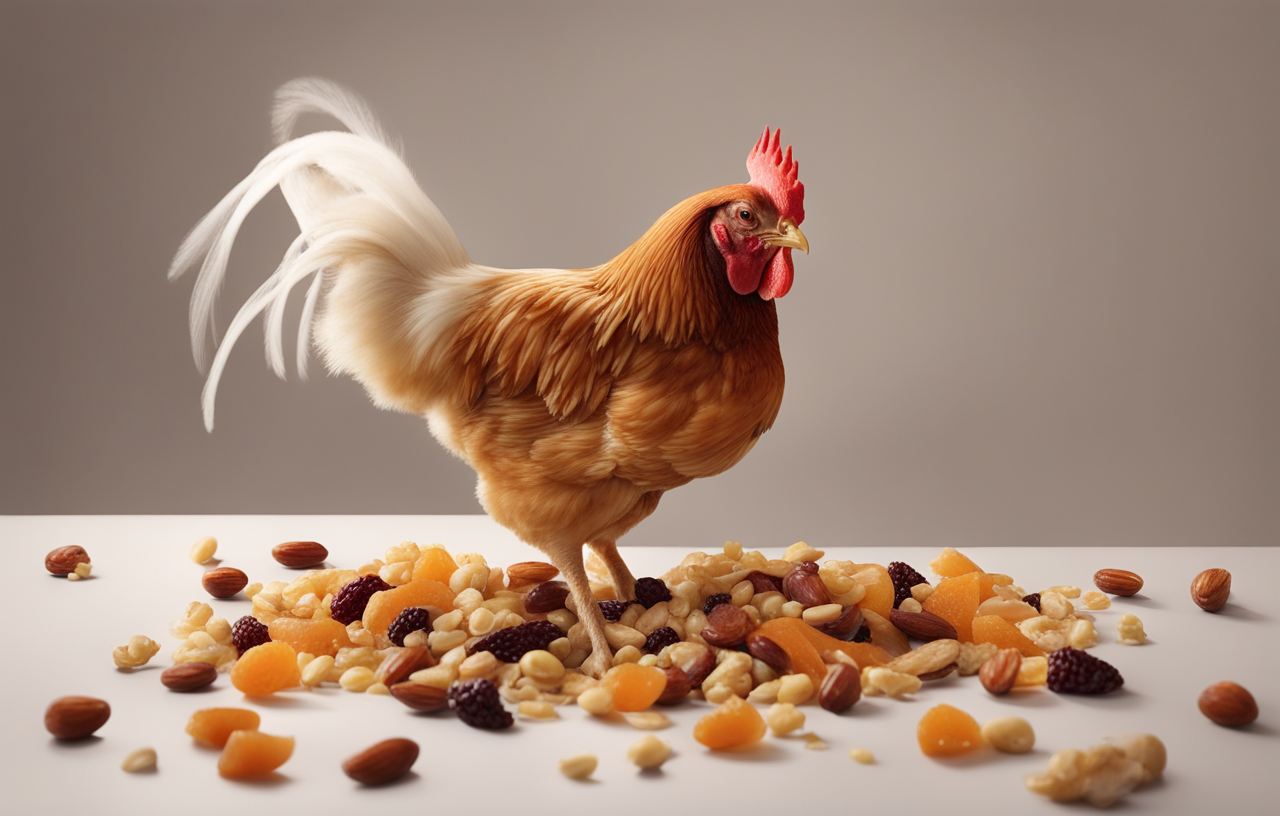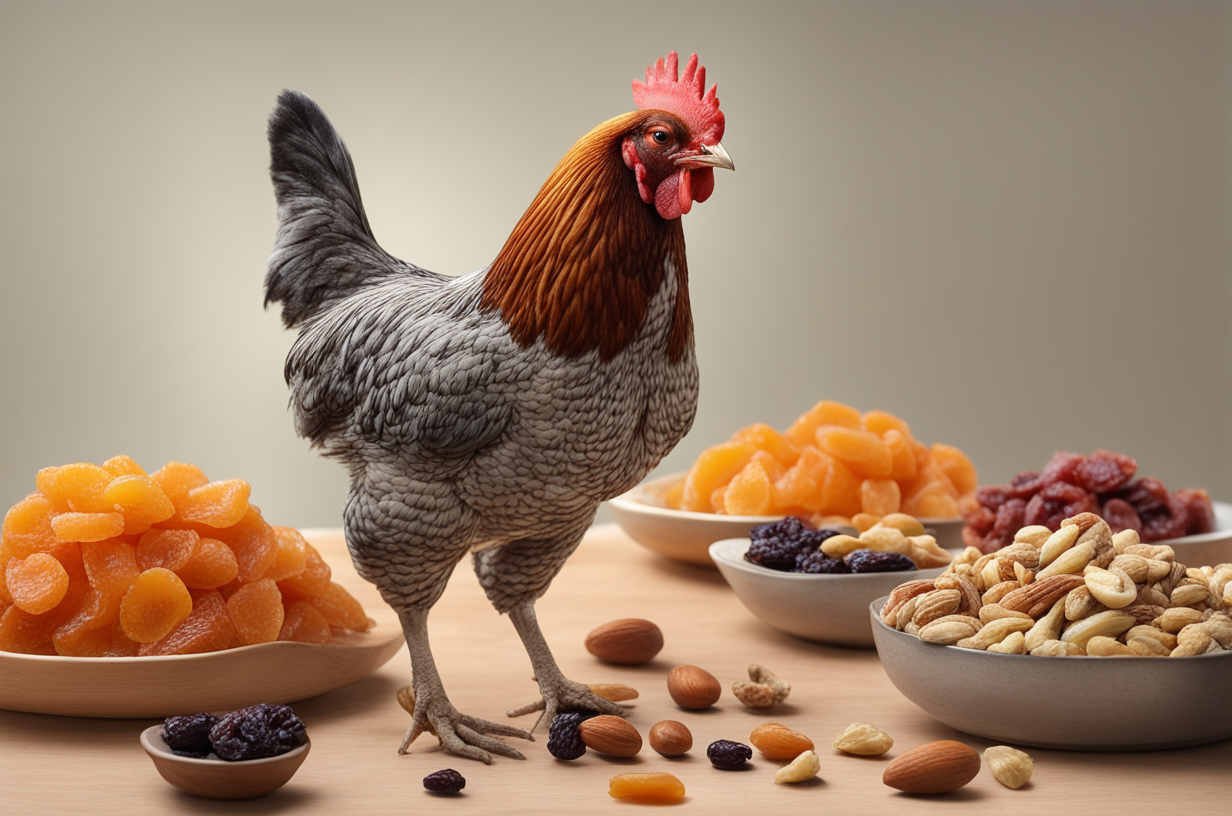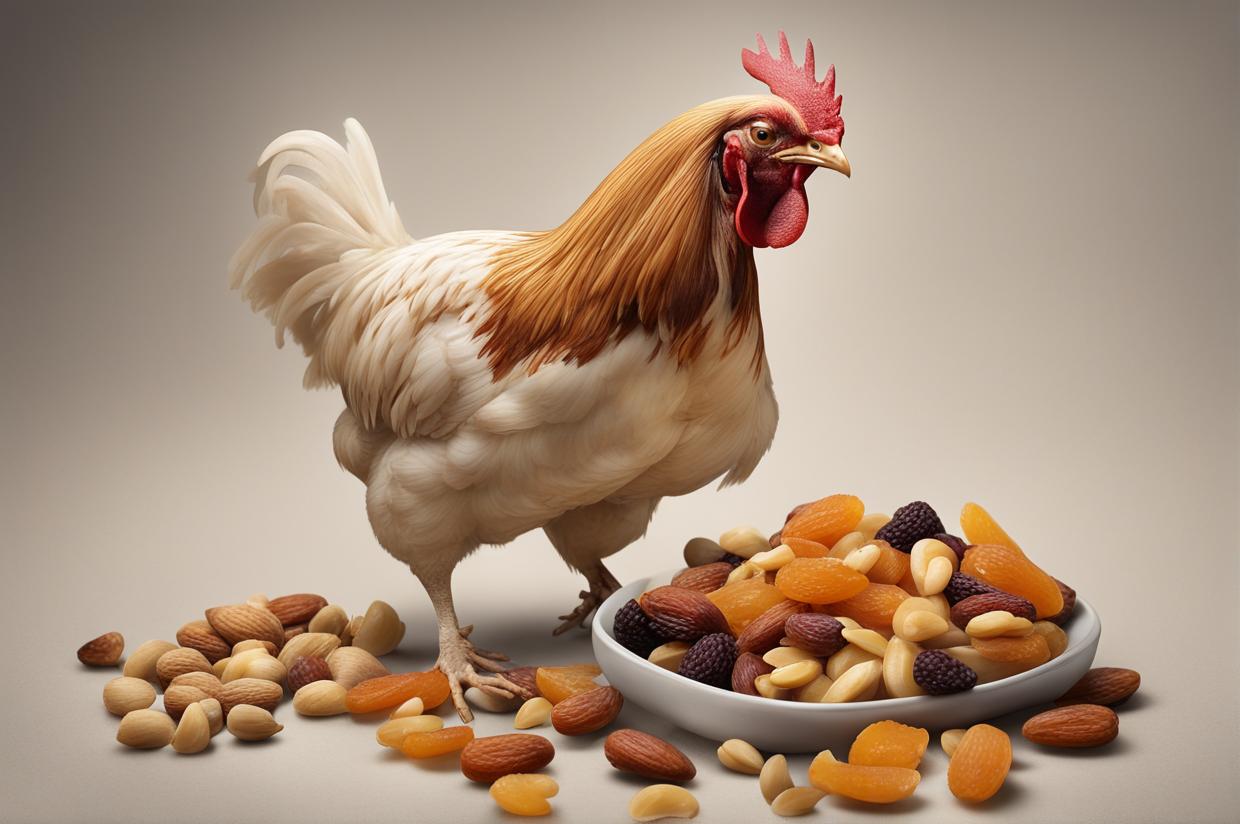Well folks, I learned this lesson the fun way.
I was out in my coop collecting eggs when I heard some commotion.
My feathery ladies were in an uproar over something.
To my surprise, they had knocked over a bag of trail mix that my son had accidentally left in there after helping me clean the coop the day before.
Those sneaky chickens had broken into the bag and were gobbling up the dried cranberries and pecans like there was no tomorrow!
Silly me, I never considered that chickens might take a liking to human snack food.
Polly, my leading lady, was chasing all the other hens around to hog the rest of the loot for herself. What a scene it was!
Turns out, chickens absolutely can and do enjoy dried fruit and unsalted nuts in moderation.
In fact, they provide some healthy benefits to their diet.
But before you raid the bulk food aisle at the grocery store, read on for more details.
Table of Contents
Fruits Pack a Punch
Dried fruits like raisins, cranberries, apples, pineapple, papaya, and banana make great occasional treats.

Just remember fruits contain natural sugars, so moderation is key for chicken health. About 1-2 bite sized pieces per chicken per day is plenty.
I usually give my flock of 12 ladies one handful of mixed dried fruit two times per week.
Fruits provide vitamins and antioxidants that boost chicken immunity and health.
Anthocyanins in cranberries and carotenoids in papaya, for example, act as anti-inflammatories and support reproductive health.
Blueberries are loaded with immune-boosting antioxidants too. I’ve also read that kiwi fruit improves respiratory health.
In the summer months, I offer my flock melon rinds left over from my family’s watermelon slices.
They go crazy running over to peck out all the sweet fruit still clinging to the rind! It keeps them hydrated on hot days too with all that juicy melon moisture.
However, some fruits are toxic for chickens, like citrus fruits which can damage liver function.
So know what’s safe before tossing your chickens food scraps!
Nuts Offer Nutrition
Unsalted nuts like almonds, walnuts, pecans, and peanuts also make satisfying snacks. Again, don’t go nuts! Give chickens only a few bite-sized nut pieces daily.

High fat content can upset their digestive systems. I portion out an eighth cup of nut pieces to share between my 12 ladies.
Nuts contain plant protein for egg production as well as omega fatty acids for healthy brains, nerves, and feathers. Walnuts are loaded with brain-boosting omega-3s! Just be sure to avoid moldy nuts or anything spoiled.
Nut shells can also provide entertainment! I often leave whole nuts in shells scattered in their run.
My chickens will peck and scratch for hours working to crack open the shells and get the treasure inside. It keeps them busy on rainy days when they can’t free range outdoors.
However nuts and seeds high in oils can cause digestive upset. So keep an eye out that nut pieces aren’t causing loose stool or other tummy troubles. And definitely steer clear of salt laden party mixes!
Avoid Choking and Always Supervise
Even healthy treats come with some risks. Make sure all dried fruits and nuts are chopped into appropriately tiny pieces before feeding chickens.

I aim for pea sized nibbles. Entire large pieces can pose a choking hazard or get stuck in chickens’ crops!
It’s also wise to scatter dried treats in chickens’ bedding, grass, or bare dirt to encourage natural foraging rather than dump piles straight into feed troughs.
This prevents bossy birds from hogging the goods and promotes healthy activity. Trust me, chicken hierarchy is alive and well in every flock!
My top queen hen Henrietta will stand in the feed tray and announce a loud “BOCK BOCK” call whenever I come around with special snacks. All the other hens come a running to vie for first dibs!
And as always, supervise snack time. You don’t want dried fruits and nuts to completely replace balanced feed. Pay attention to how different flock members respond and adjust portions accordingly. Remove extras if any chickens fill up too much on fruit and turn up their beaks at their layer feed.
Well folks, I hope this gives you the inside scoop on sharing trail mix and fruit scraps with your flock! Just remember–moderation, supervision, and safety first. Happy snacking!
Storing Dried Fruits and Nuts Properly
Before serving up any dried snacks, be sure you store them properly to maximize freshness. I like to store bulk bags of dried fruit and nuts in my basement pantry where it’s cool and dark. Light, heat, and moisture cause oxidation and nutrient breakdown.
To prevent spoilage after opening, transfer servings from large bulk bags into smaller airtight containers. Glass jars or sturdy plastic works well. Always press out excess air before sealing to prevent moisture buildup that leads to mold.
Date your storage containers and use oldest ingredients first. Dried fruit lasts 6-12 months, while shelled nuts go rancid faster around 4-6 months. Discard anything that smells bitter, looks shriveled, or shows visible mold.
For the choosiest of chickens with the most discerning palates, use dried fruit within 2-3 months for peak flavor and nutrition. Fresher fruit retains more vitamin C and antioxidants that degrade over longer storage.
Check storage conditions regularly too. Fluctuations in humidity or temperature can accelerate staleness. No one likes a stale raisin or spoiled peanut! And certainly not a chicken expecting her cherished treats.
Pairing Fruits and Nuts for Balanced Nutrition
For the optimal nutritional boost, look for pairing dried fruits and nuts in chicken treats. Fruits offer a hefty dose of carbohydrates and antioxidants, while nuts provide protein, healthy fats, and metabolic support.
Some smart pairings to try include: almonds with tart cherries or dried cranberries, walnuts with dried apple or apricot, pecans with golden raisins or pineapple, and peanuts with banana chips or shredded coconut.
Herbal health blends also make great additions to fruit and nut mixes! Maple Pecan Cranberry clusters rolled in cinnamon and turmeric make a warming winter treat. Curried Cashew Raisins with shredded coconut and ginger are nice for springtime. Custom blends are endless!
Or get creative repurposing your leftover chicken scratch grain into snack mixes too. Toss together whole grain oats, cracked corn, barley, millet or sorghum grains with assorted dried fruits, seeds, herbs and spices for a nutritionally balanced homemade blend.
Regulating Treats for Healthy Weight Maintenance
While nutritious and enjoyed in moderation, too many high carbohydrate dried fruit treats lead to obesity in chickens just like humans. Plump hens have trouble getting around to exercise, forage, perch, and lay eggs in nest boxes.
Pay attention to your chickens’ body conditions and cut back treats if any birds become too round. Heavy breeds like Orpingtons and Rhode Island Reds prone to fat buildup may only tolerate dried fruit nibbles a few times a week.
Free feed a quality complete chicken ration at all times as the dietary foundation. Limit high calorie dried fruit and nuts to under 10% of total feed volume per day for most backyard flocks.
Scatter treats widely around runs and coops to promote foraging habits rather than gobbling up pile-ups. Keep an eye on social order too – bossy birds chase timid ones away then hog all the best snacks!
Organic and Non-GMO Feeding Practices
As a small scale backyard chicken keeper, I choose dried fruits and nuts grown organically without GMOs whenever possible minimize my chickens’ exposure to synthetic chemicals.
While not always feasible budget-wise, prioritizing organic really pays off long term in vibrant bird health, quality eggs, and peace of mind about what goes into my flock’s beaks.
I shop around near expiration dates for deals on organic nuts and fruit. Buying past crop year clearance further cuts costs, though shelf life is shortened. Frozen berries are a nice organic option lasting longer too.
When conventional grocery store mainstream brands are all my budget allows, at a minimum I inspect labels and avoid ingredients with long chemical names. Say no to preservatives, oils, added sugars and salt bombarding your flock!
Dried Fruit & Nut Allergy Risks
Allergy risks do exist when introducing new dried fruits and nuts not typically found in commercial chicken feeds. While less common in birds than humans, some individuals react poorly.
Allergy symptoms like itchy skin, feather picking, head shaking, watery eyes, sneezing or wheezing after treat time may indicate sensitivities. Carefully observe all flock members following any new additions.
Eliminate suspect trigger foods from diets immediately if adverse reactions present. In severe cases, an avian veterinarian can help diagnose and provide supportive treatments for comfort.
Note any ingredients that consistently cause issues and avoid feeding those items to reduce recurrence. With hundreds of fruit and nut possibilities, there’s still plenty left to safely enjoy!
